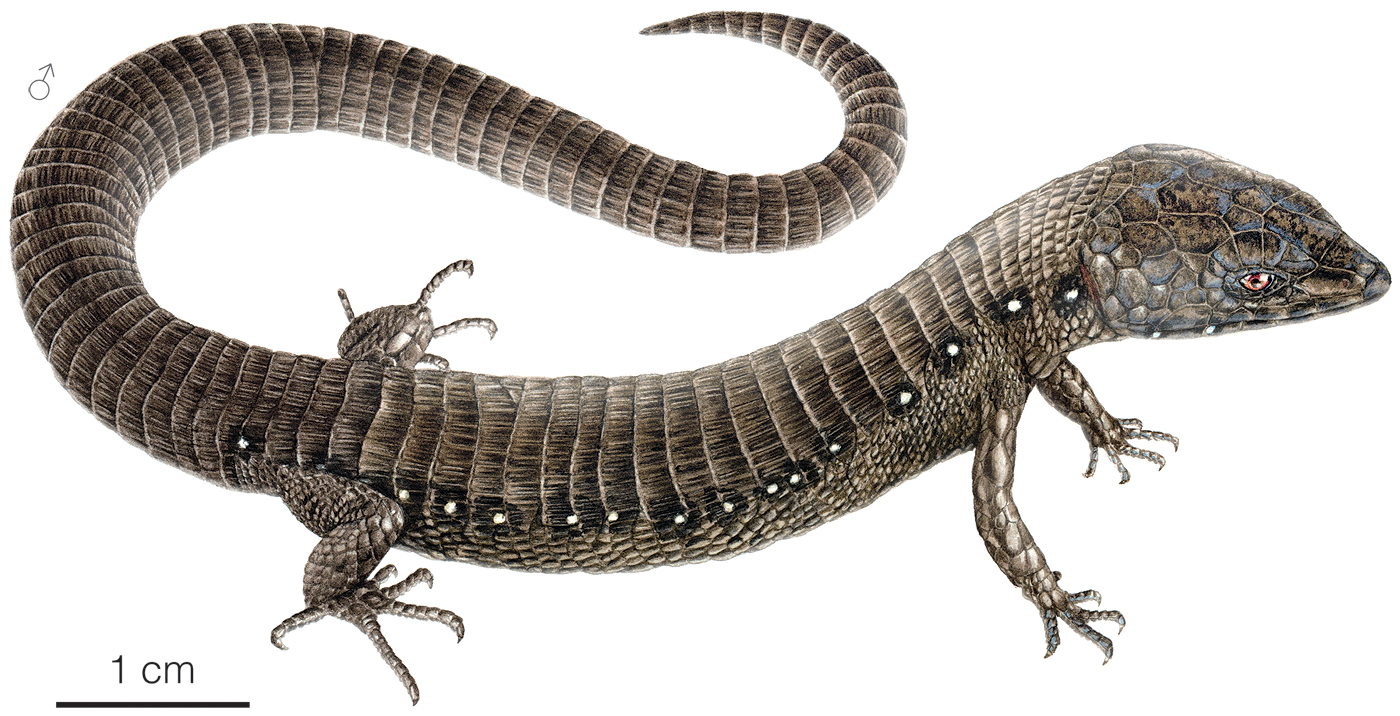Published July 14, 2023. Updated November 19, 2023. Open access. Peer-reviewed. | Purchase book ❯ |
Peters’ Andean-Lizard (Andinosaura petrorum)
Reptiles of Ecuador | Sauria | Gymnophthalmidae | Andinosaura petrorum
English common name: Peters’ Andean-Lizard.
Spanish common name: Lagartija andina de los Peters.
Recognition: ♂♂ 16.7 cmMaximum distance from the snout to the tip of the tail. Snout–vent length=7.2 cm. ♀♀ 17.6 cmMaximum distance from the snout to the tip of the tail. Snout–vent length=7.6 cm..1 The Peters’ Andean-Lizard (Andinosaura petrorum) differs from all other lizards in its area of distribution by lacking prefrontal scales and by having a dark grayish brown dorsum with extremities long enough that the front and hind limbs overlap when pressed against the body.1 Adult males of this species have a series of 20 black ocelli (Fig. 1) along the flanks; in females, there is a series of dark lateral spots rather than complete ocelli.1 This species co-occurs with two lizards of the genus Riama, both of which have shorter limbs.1

Figure 1: Illustration of an adult male individual of Andinosaura petrorum.
Natural history: Andinosaura petrorum is an extremely rare lizard that inhabits old-growth cloud forests.1 Andean-Lizards in general are cryptozoic, meaning they prefer moist, shaded microhabitats such as streams with abundant leaf-litter.2,3 Based on its morphology, Peters’ Andean-Lizards are presumably able to climb and are at least partly arboreal. Almost nothing is known about their natural history, but other Andinosaura lay clutches of three eggs in holes in the forest floor.2
Conservation: Endangered Considered to be facing a high risk of extinction in the near future..4 Andinosaura petrorum is included in this category primarily because the species is known from only two localities, its area of distribution is extremely small (312 km2), and there is ongoing degradation of its habitat caused by logging and agricultural expansion.4 To protect this species, it is crucial to implement conservation measures aimed at mitigating habitat loss and reducing the rate of deforestation.
Distribution: Andinosaura petrorum is endemic to Ecuador. The species is known only from two localities along the Amazonian slopes of the Andes in Morona Santiago province at elevations between 2175 and 2435 m (Fig. 2).

Figure 2: Distribution of Andinosaura petrorum in Ecuador. The star corresponds to the type locality: Pailas, Morona Santiago province. See Appendix 1 for a complete list of the presence localities included in the map.
Etymology: The generic name Andinosaura, which comes from the Spanish word andino (from the Andes) and the Latin sauria (=lizard), refers to the distribution of this group of lizards.5 The specific epithet petrorum (“of the Peters”) honors German naturalist Wilhelm Peters (1815–1883), in recognition of his contributions to Gymnophthalmid systematics. It is also a patronym for the collectors of the type material, Peter Spoecker and American herpetologist James A Peters (1922–1972), the latter of whom made significant contributions to the knowledge of Neotropical reptiles, particularly those from Ecuador.1
See it in the wild: Andinosaura petrorum is Ecuador’s rarest lizard species, with only three specimens ever recorded. Search parties of biologists have failed to locate the species since it was last seen in August 1962. This could be due to these lizards secretive and arboreal habits or to actual low population densities.
Author: Alejandro ArteagaaAffiliation: Fundación Khamai, Reserva Arlequín, Ecoruta Paseo del Quinde km 56, Santa Rosa de Mindo, Pichincha 171202, Ecuador.
Academic reviewer: Jeffrey D CamperbAffiliation: Department of Biology, Francis Marion University, Florence, USA.
Illustrator: Valentina Nieto Fernández
How to cite? Arteaga A (2023) Peters’ Andean-Lizard (Andinosaura petrorum). In: Arteaga A, Bustamante L, Vieira J (Eds) Reptiles of Ecuador: Life in the middle of the world. Available from: www.reptilesofecuador.com. DOI: 10.47051/BCWP5374
Literature cited:
- Kizirian DA (1996) A review of Ecuadorian Proctoporus (Squamata: Gymnophthalmidae) with descriptions of nine new species. Herpetological Monographs 10: 85–155. DOI: 10.2307/1466981
- Arteaga A, Bustamante L, Guayasamin JM (2013) The amphibians and reptiles of Mindo. Universidad Tecnológica Indoamérica, Quito, 257 pp.
- Sánchez-Pacheco SJ, Aguirre-Peñafiel V, Torres-Carvajal O (2012) Lizards of the genus Riama (Squamata: Gymnophthalmidae): the diversity in southern Ecuador revisited. South American Journal of Herpetology 7: 259–275. DOI: 10.2994/057.007.0308
- Cisneros-Heredia DF (2020) Andinosaura petrorum. The IUCN Red List of threatened species. Available from: www.iucnredlist.org. DOI: 10.2305/IUCN.UK.2020-3.RLTS.T178746A54447491.en
- Sánchez‐Pacheco SJ, Torres‐Carvajal O, Aguirre‐Peñafiel V, Sales-Nunes PM, Verrastro L, Rivas GA, Rodrigues MT, Grant T, Murphy RW (2017) Phylogeny of Riama (Squamata: Gymnophthalmidae), impact of phenotypic evidence on molecular datasets, and the origin of the Sierra Nevada de Santa Marta endemic fauna. Cladistics 34: 260–291. DOI: 10.1111/cla.12203
Appendix 1: Locality data used to create the distribution map of Andinosaura petrorum in Ecuador (Fig. 2). Go to the section on symbols and abbreviations for a list of acronyms used. Asterisk (*) indicates type locality.
| Country | Province | Locality | Source |
| Ecuador | Morona Santiago | Pailas* | Kizirian 1996 |
| Ecuador | Morona Santiago | San Vicente | Kizirian 1996 |